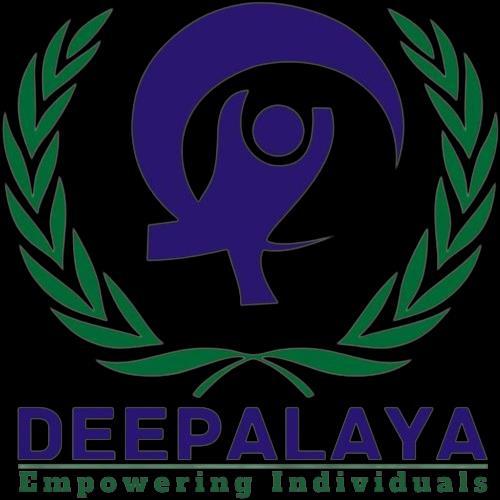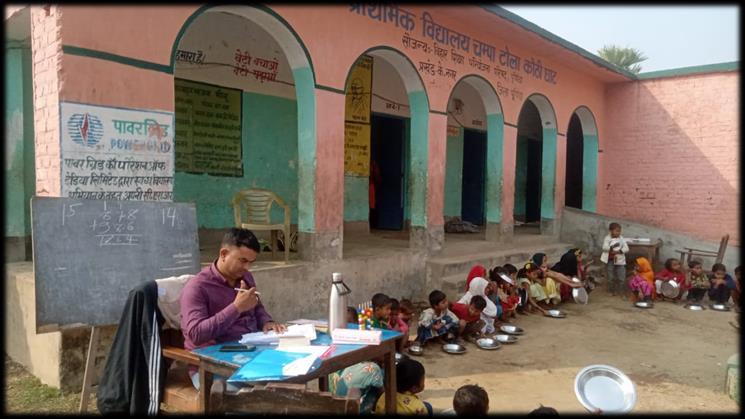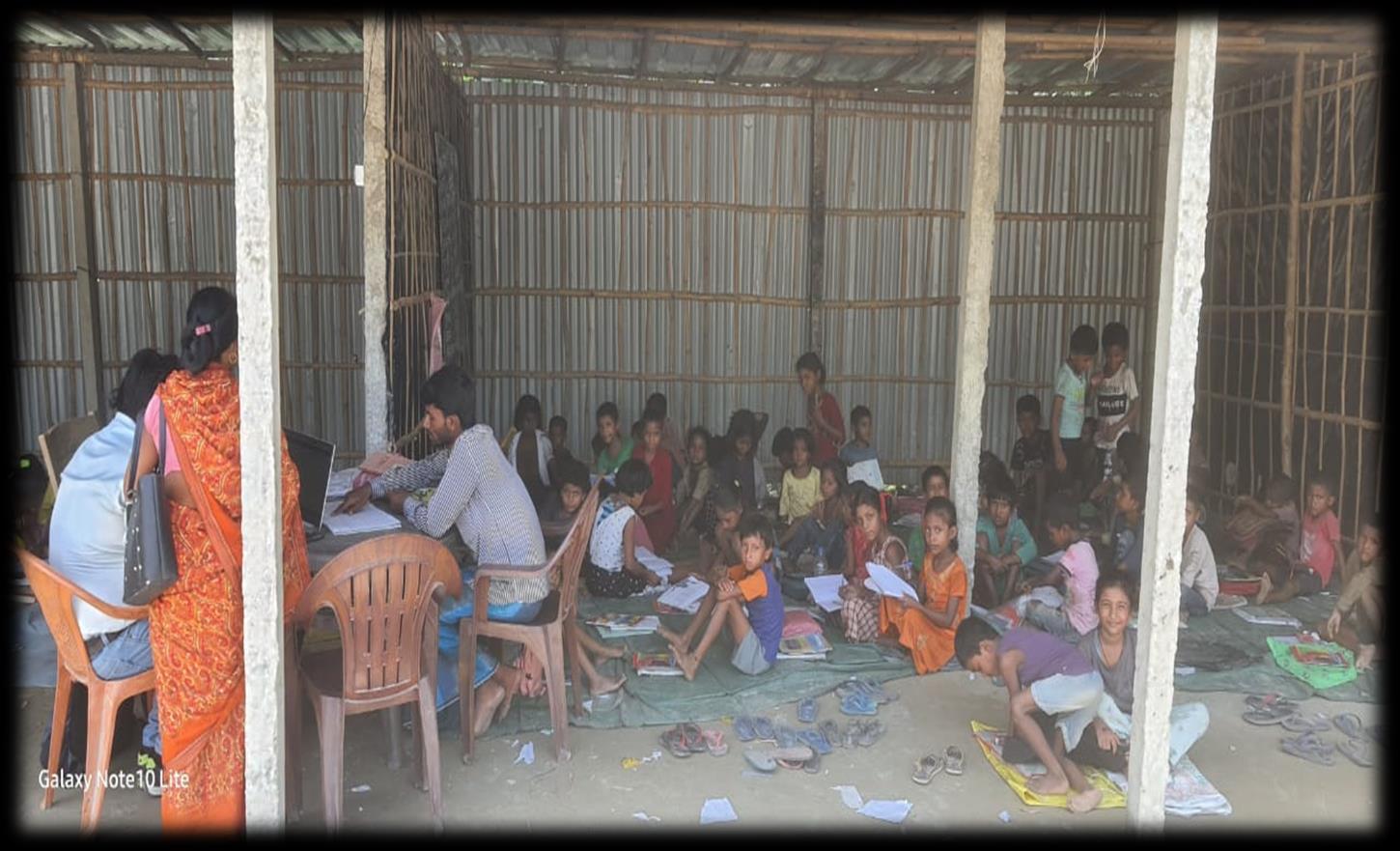

ProjectStatus Report on Enrolment of 2000 (OOSG)
SEPT2022-DEC2023
Deepalaya Mansik Swasthya Evam Viklang Punarwas Sansthan
Admin
Deepalaya Mansik Swasthya Evam Viklang Punarwas Sansthan
Out of School Girls Purnia,Bihar
Office: SS0092, Nh-31
Road, East of Newalal Chowk, Madhopara, Purnia, Bihar ISO Certified 9001: 2015
Bypass
Table of Contents 1. Introduction 03
EducationScenarioinBihar 05 3. MaitriProject 09 4. ProgramStrategy&Outcome 10 5. Lessonslearned 15 6. Conclusions 16
2.
DeepalayaM.S.E.V.P.Sisanon-profitorganisationbasedinPurnia,Biharand foundedin1994.ItwasestablishedonlyasaHealthandRehabilitationUnitunder Nehru Yuva Kendra Sangathan, in 1991, under the leadership of Dr. A. K. Raman. Analysingtheneedofthehour,thethenDistrictYouthCoordinatorShriZ.A.Mian urged that this unit has the potential to cover a wider beneficiary base and therefore needs to establish itself as an independent social welfare organisation (NGO).In1994,Deepalayawasestablishedasanindependentorganisationandin 1999 it got its first recognition as a Non-government Organisation under Govt. of Bihar; with prime focus improving education, vocational and emotional needs for personswithdisabilityandprovidingthemcareandrehabilitation.Deepalayahas beenfunctionalinthePurniaandnearbydistrictslikeKishanganj,Katihar,Supaul and Araria for over3 decades. Through thecontinuousefforts put in bythe team, wehavecreatedabenchmarkforourselvesintheupcomingfuture.Withtheneeds arising,Deepalayahasexpandeditsaidsandservicestowardswomen,adolescent, and girls by helping them advocate towards their basic needs for education and livelihood support. Deepalaya leverages community and government resources to create a broader and unbiased approach towards its initiatives. It partners with various government and non-government institutions and organisations, nationwide and overseas, to render its services across various landscapes. Over thepast29years,ithasestablishedtestimoniesthatjustifyourdedicationtowards creatingasocietywhereeveryindividualisempoweredandembraced.
MaitriProject,aoneofakindprojectthatfocusesoncreatingeducationneedsfor children, especially girls. The project is implemented with support and guidance from an overseas organisation - Educate Girls US. The project aims toward improving girls’ enrolment, retention, and academic performance in government schools by leveraging existing community and government resources. Project Maitri is transforming the school system by engaging girl leaders, their communities, and the government. The key success factors have been leveraging thepowerofexistingvillagecommittees,meetings,andPRI’s.
Girls are often counted as some of the hardest to reach children. They face numerousbarriersintheireffortstoacquireformaleducation. Thesebarriershavebeengroupedintoninemajorcategories:
•Socialandculturalbarriers
•Economicbarriers
•Psychologicalbarriers
•Institutionalbarriers
•Barrierscausedbypoorteaching-learningconditionsinschools
1. Introduction:
•Barrierscausedbyfamilycircumstances
•Geographicbarriers
•Mentalandphysicalbarriers
•Barrierscausedbyarmedconflict
Deepalayahasreachedoutto65,600householdsinover144villagesacrossfourblocks (PurniaEast,Kasba,K.Nagar,andDagarua)inBihar'sPurniaDistrict.Duringtheproject's duration(Sept2022-Dec2023),Deepalayahasenrolled2121OOSG(5-14Years)in136 schoolsacross94villages.

2. Education Scenario in Bihar
Bihar is a large state in India, with a children population of 22,359 thousand, accountingfor11.79percentofIndia'stotalpopulation(1,89,593thousand)aged6to 14 years. Bihar is home to nearly every 12th child in India, aged six to fourteen. In addition,Biharishometo93,459(6.19%)ofthetotal15,09,136schoolscoveredunder UDISE2020-21.WithoutBiharachievingthestatusofuniversalschooleducation,India wouldbeunabletoreach thegoal,which requiresdeterminedeffortstocompletethe unfinished assignment. Bihar, like other Indian states, has gradually moved towards universalization. With a little effort, it can quickly achieve the aim of universalizing basiceducation,whichwouldeventuallybenefitIndia.
According to the Samagra Shiksha Report Card-Bihar Enrolment 2020-21 - “Primary enrolment is inconsistent with highest 15.88 million in 2011-12 & the lowest 11.23 million 2005-06. In the latest 2020-21, it was reported to be 13.73 million. Goal of universalenrolmentinthestateisstillfaroutofreach,concertedeffortsarerequired atupperprimarylevelofeducationastheGrossEnrolmentRatio (GER)in2020-21is reported to be 83.2 percent. Enrolment Ratio at the Hr. Secondary level is as low as 34.78%.”
Bihar has achieved significant progress in terms of schooling infrastructure and school-based universal schooleducation.However,theobjectiveofuniversal enrolment remains a faraway dream, as evidenced by many factors analysed in the Samagra Shiksha State Report Card for 2020-21. One of the most significant issues that the state continues to face is the quality and trustworthiness of its educational data, particularly enrolment numbers, which are very variable. The rapid ups and downs in enrolment make determining enrolment trends difficult, especially in the elementary and upper primarylevelsofeducation.Asaresult,thedifferent enrolment ratios being discussed is no longer valid inassessingthestateofschooleducationinIndia.


International legal obligations: Underinternational human rights law children hold civil, cultural, economic, political, and social rights. These rights are formally guaranteed in international legal instruments, such as the Universal Declaration of Human Rights, International Covenant on Civil and Political Rights (ICCPR), and
International Covenant on Economic, Social and Cultural Rights (ICESCR) – and other coreinstruments.Theseprovideseveralprotectionsforchildren.
India isapartytotheCRCandisrequiredtoensurethatCRCprovisionsandprinciples arefullyreflectedandgivenlegaleffectinitsdomesticlegislation.
TheCRCadvocatesseveralrightsofallchildren,asmentionedahead:
1.therightstoaccesshealthcareandeducation;
2.tosocialsecurity;
3.tobirthregistration;
4. to the right to protection from: arrest and detention, except as a means of last resort;
5.Protectionafterseparationfromparents;and
6. The right to special protection and assistance when deprived from a family environment. All children also have a right to be protected from economic exploitation,hazardouslabour,andviolence.
Rationale- Dropout Situation (Purnia)/Problem Statement
Purnea is a backward district often referred to as the Kala-a-pani of Bihar. It is also a disability specific district having the largest number of the divyangjan in any one district of Bihar. Poor socio-economic conditions, low per capita income, less opportunities of livelihood generation make Purnea a vulnerable district to many angels.ThedataavailabilityofstudentsinPurneadistrictisverysketchy.Fromvarious sources,wehavecollectedsomedataandcanconcludethefollowing:
Demography:
1. Theproportionatepopulationofboysandgirlsis(17%)and(16%)respectively.
2. SexRatio:2011:930,alsohighMMRamongfemalesduetoteenagemotherhood.
3. Distribution of population: Total student population (Std I -XII): 885000, Total girlstudentpopulation:368000(41.58%)(Roundedfigure)
Health:
1. Malnutritionprevailsamongthestudents,especiallygirls.
2. Age-specificmortalityis3and3.4respectivelyforboysandgirls.
3. The%ofstudentsmarriedbeforeis18inBihar(71%)(NFHSReport)
4. FertilityRate:NFHSIsay36%ofmarriedadolescentsintheagegroupof13to16 arealreadymothersorarepregnantwiththeirfirstchildasare64%ofthosein the17to19agegroup.(CSO,1998)
Education:
1. EducationandLiteracy%byCensus2011:52.49(Total),61.09(M),43.19(F)
2. ThedropoutratesinclassesItoXisaround37%.
3. 40% of students feel difficulty concentratingontheirstudiesand 37%fearexamsandfailure.
4. 73% and 56% students felt it tough to talk to their parents and friends respectively about their problems.

5. The Gross Enrolment Ratio (GER) has increased remarkably. The PupilteacherRatio(PTR)isyetto be improved. Dropout rates year wise, level wise and with relations to gender needsattention.MaximumdropoutisseeninStd.IXandX.Theratiodifference ofdropoutbetweenboysandgirlsisnegligible.
6. The gender parity index, Inequality indices and redistributive gender status mappingisdifficultfornon-availabilityofdatarightnow.
7. That Purnea falls in the child labour zone of Bihar and poor socio-economic conditions, child labour economics, labour contractors, child trafficking for labourandotherabuseiscommonlyseen.
8. Covid-19 has further furthered the drop out data of the district. This has been reportedinvariousgovernmentalandnon-governmentalreports.
9. Thesituationofdropoutgirlsismuchworseastheyaretemptedandtrafficked by various antisocial elements in the name of labour but engaged in different exploitativework,beginningfromagriculturallabourtodomesticlabourandsold inbrothelsofdifferentcitiesofIndiaforphysicalandsexualabuse.
Labour:
Majorsectorsofdropoutandoutofschoolchildrenworkinginarethefollowing:
1. Pan,BidiandCigarettessellingConstructionDomesticWorkers
2. Spinning/WeavingFisheriesandMakhanaProcessingBrick-kilns,Tiles
3. Dhaba/Restaurants/HotelsAutoworkshop/VehicleRepairCarpet-making
4. BeggingCrimeandoffencesothers
Importance of Education:
Womenwhohavegonetoschoolare50%morelikelytoimmunisetheirchildren.Over the previous 25 years, gains in female education have accounted for over 40% of worldwidehungerreduction. Girls'educationbenefitsboththecommunityasawholeandtheindividualwoman.
AccordingtoUNandWorldBankdata:
● Educating females decreases birth rates and family size by one for every four yearsofschooling.
● Family health increases, while infant mortality decreases; educated moms are 40%morelikelytoimmunisetheirchildren.
● Literacyratesriseinsubsequentgenerations,sinceeducatedmomsarefive timesmorelikelytoeducatetheirchildren.
● Regionsstabiliseasviolenceandextremismdecrease.
● Eachadditionalyearofschoolingincreasesfamilyandnationalincomeby10%.
●
Many communities have female youngsters who are difficult to reach and hence miss out on the advantages of education. This is particularly prevalent in tribal areas and among the scheduled castes. Deepalaya works with the government and local communities to provide great education and self-development opportunities for girls infourPurniaDistrictblocksthroughaprogrammaticstrategy. It is well researched that educating a girl has a ripple effect, impacting health, populationcontrol,schoolenrolmentandthepotentialtoearn.Educationenablesgirls tomakeinformeddecisionsandmostimportantly,livehealthyandproductivelives.
 Maitri Team-Purnia conducting enrolment in a government school (in session)
Maitri Team-Purnia conducting enrolment in a government school (in session)
3. Maitri Project
Deepalaya launched a pilot phase of the Project Maitri (Cohort-1) in four blocks of Purnea District. The MOU between Educate Girls US and Deepalaya M.S.E.V.P.S was signed on 27th August 2022. On 1st September 2022, d2d survey was initiated in all four blocks- Purnia East, Kasba, Krityanand Nagar, Dagarua; to study and identify the numberofOOSG/dropoutsandthereasonfortheirdropoutfromtheschool.
Vision:
Reversalof 2000 dropout girl students backtoschoolinPurniaDistrict.
Mission:
1. Identifyingdropoutgirlsbyconducting d2d (Door-todoor) Survey.
2. Enrolmentofidentifiedgirlsingovernmentschool.
3. Conducting retention for enrolled students through dailyschool/householdvisit,conductingcampaignsto enhanceparticipationofmothersinsendingtheirgild childtoschool.
4. Counselling of drop out students and their parents to promote maximum conversions of dropouts into regularstudentsinschools.
5. Community awareness on girl child education so that community-imposed gender biassed inhibitions are reduced.

6. Counselling of Principals and Teachers of schools for bringingbackdropoutgirlstudentsbackintheschoolasperGovt.directives.
Objectives:
1. To sensitise government officials, PRIs, SMCs, and community on RTE and specific educationalproblemsofgirlsandunderprivilegedcommunities.
2. To educate the community on RTE and other people's oriented acts, schemes and programsandencouragethemtoarticulatetheirgrievancesandredressalprocedures fordropoutgirlstudentreversalinschools.
3. To encourage students of underprivileged communities in general and girls in particularbyprovidingthemopportunitytodisplaytheirinherentvisionarycapacities andtobuildthecapacityofgirlstudentstobefuturesocialfacilitators.
The strategy proposed for addressing dropout rates in Purnea district is structured intothreekeysegments. The first segment focusesontheselectionprocessforhuman resources, with further details providedintheProgram Implementation Plan(PIP). It aimstoensuretheeffectiveidentificationandutilisationofpersonnelfortheinitiative. The second segment involves kick-starting and supporting operational activities, includingorientations, trainingsessions, andcommunityinteractions. These activities arevitalforcreatingawarenessandgarneringsupportforthedropoutreversalefforts.
The third segment encompasses mainstream activities geared towards dropout reversal.Thisincludesconductingbaselineassessmentsandsurveystounderstandthe factors contributing to dropout rates, such as socio-economic, cultural, and legal barriers. Additionally, it involves assessingthestatusofSchoolDropout Management Committees in each school and implementing measures to strengthen them, such as forming committees and developing dropout response procedures. Furthermore, it emphasises the development of school-specific Dropout Management

Planstailoredtoaddresstheuniquecharacteristicsofeachinstitution.Regularreview, revision,andsharingoftheseplanswithstakeholdersareessentialcomponentsofthis process.
Awareness-building activities emphasise the importance of education and involve activedialogueswith localserviceproviders.Exclusiveinitiativeswithinschools,such as developing child reporters and organising various competitions, aim to empower studentsandreducedropoutrates.
Initiatives for dropout redressal activities involve conducting assessments to identify existing problems and developing action plans to address them. Ensuring schools adhere to minimum standards and implementing routine checks are crucial for maintaining the effectiveness of dropout management measures. Regular assessment andupgradationoftheperformanceofpoorstudents,alongwithperiodicreportingof developments,areintegraltosustainingprogressinreducingdropoutrates.
4.
Program Strategy and Outcome {Enrolment of 2000 OOSG (Out of School Girls}
Project Outcomes:
1. Number of total OOSG Enrolments –2,121 (5-14 years)
2. Identification of Out of School Girls -
The identification method consists of a door-to-door survey carried out by means of digital forms, which includes multiple checkpoints designed to separate the appropriate age group of children based on official identity verification. Deepalaya conducted a door-to-door household survey in the villagesincludedbytheprojectaspartofthebaselineidentificationsurveyat thestartoftheproject.
IdentifiedOutOfSchoolChild(boys&girls)(3-14Years)


Identificationof
Out
OfSchool Girls(5-14Years)
0 100 200 300 400 500 600
Drop Out Enrolled but Never Attended Never Enrolled
Dagarua K.Nagar Kasba Purnia East
3. Enrolments per block

In Cohort-1, significant milestones have been achieved in the operational areas of Purnia District, specifically in Purnia East Block, Kasba Block, Dagarua Block, and KrityanandNagarBlock.Thefocushasbeenonbenefitinggirlchildrenagedbetween5 to 14 years old. Across 144 villages, a total of 65,589 households have been covered. Within these areas, 3,470 out-of-school girls (OOSG)havebeenidentified,withanaverage of 24 OOSG identified per village. This effort has encompassed the coverage of 136 schools, indicating a comprehensive approach to addressing educational needs within the community. 1162 girls remained outofschoolandcouldnotenrolintoschools due to unfavourable socio-economic circumstances. An attempt is made to enrol thesegirlsintheSecondPhase.

(September 2022- December 23): 106% Enrolment achieved vs target in Cohort-1

0 100 200 300 400 500 600 700
Dagarua K.Nagar Kasba Purnia East
School wise enrolment data of Out of School Girls (7-14 Years)
Block: Purnia East
Block: Dagarua
School Name OOSG Enrolled BSCHANDIRAJIGANJ 5 MSMAHENDRAPUR 15 MADANADARSHAMSHARADA 10 MadarsaIslahulMusleminKamalpur 10 MSFARIYANI 9 MSARANIPATRA 18 MSBAIRBANNA 9 MSBELWA 11 MSBIYARPUR 38 MSCHANDIKATHWA 5 MSDALIAHUSENABAD 14 MSGOURA 12 MSLALGANJ 22 MSMAHARAJPUR 1 MSMAJHUA 14 MSMATIA 19 MSPARMANANDPUR 7 MSRAMPURGHORGHAT 22 MSSINGHIYADIVANGANJ 35 MSTHADHA 15 PSKuddusTola 7 PSANDAILI 5 PSBAHADURPUR 5 PSCHHTIYA 5 PSDARGAHA 19 PSFASIAMASJIDTOL 48 PSGHUSKITOLA 4 PSGIRLSMAHENDRAPUR 2 PSHARIJANRAJIGANJ 17 PSKHAKHOBARI 6 PSMUKHIYATOLALALGNAG 12 PSPIPRA 10 PSRAMGHAT 13 PSSHEKHAPURA 21 PSSHERSAHAWADITOLALALGAN 12 PSSHRENAGAR 4 PSTHADAMUSAHARI 4 PSUCHITPUR 35 Total 520
School name OOSG Enrolled MSSindhiya 79 MSBABHNI 3 MSBEIGACCHI 7 MSCHANPI 1 MSDASPATTAR 24 MSGANDWAS 54 MSMAHTHOR 7 MSMAKAILI 34 MSSIARKHAM 3 P S ANUSUCHIT JATI TOLA MAHTHORH 15 P S BABHNI SANTHALI TOLA 1 PSChandbhatiPurabTola 11 PSHathiaGhatTola 21 PSSINDHWA 12 PSBHADARA 1 PS BISHWASPUR KAJALA RAHIKA 2 PSBUARI 17 PSCHAMUAA 4 PSCHANDBHATI 15 PSCHIKANITOLA 38 PSDAKAILI 17 PSEKULWA 1 PSFARKIYA 20 PS GANDUWASH HARIJAN TOLA 15 PSGEHUMAEAST 5 PSJASWA 11 PSJHURITOLA 6 PSKACHNA 10 PSKAMALPUR 1 PSKUNCHI 52 PSLASANPUR 4 PSMARNGA 19 PSMATWELI 8 PSMURAJPUR 8 PSPARMARA 1 PSPHULPURPURABTOL 4 PSPOKHRIYA 3 PSRAHIPURBARASIEA 4 PSRAJWELI 13 PSSINDHYATOLA 7 PSTAMAUT 40 PSTHATHOL 9 Total 607
School Name OOSG Enrolled MadarsaMisbahulUlumKajraBetauna 12 MadarsaRiyajulUlmMirzabariKasba 34 MSBARETASANTHAL 7 MSBASANTPUR 6 MSBETAUNA 49 MSGADHBANAILI 3 MSKAJARA 39 MSLAGAN 4 MSLALHARIA 28 MSMOHANI 48 MSSADBELI 3 PSFakirTakiya 23 PSMurliTolKamalpur 9
Block: Kasba

PSPATHANTOLAKULASUNDAR 5 PSIDGAHSAHJITOL 1 PSAADIWASITOLAMIRJABARI 30 PSBEGAMBARI 11 PSGUMTIBARETA 10 PSJANAKBAGKULLAKHAS 4 PSKAMALPUR 26 PSKANWAPARA 8 PSKHAGJANA 8 PSMOHNICOLONI 2 PSMURADBAG 1 PSPANAILABARIMOHNI 33 PSNAYATOLAMURADABAD 11 PSSIKARPUR 21 Total 436 Block: K. Nagar AMS CHAMPA NAGAR 19 Madarsa Faizul Gurba Jhunni Istambrar 4 MS ALI NAGAR CHUNAPUR 14 MS BANBHAG NORTH 3 MS BEGAM PUR KHATA 145 MS BHUTHA 12 MS CHAPAY 23 MS DAINI 4 MS ITAHWA 21 MS JAGANI WEST 3 MS JAI KRISHNPUR KATAHA 33 MS JHUNNI ISTABRAR 24 MS PRAN PATTI 7 MS SAURAHA 9 MS TIN MUHANI MOR 8 P S AADIWASI TOLA PRASADPUR BELDARI 6 P S BARKI MUSAHARI PRANPATTI 1 PS Hatdhanara 10 PS BANBHAG SOUTH 20 PS BELA 1 PS CHAMPA TOLA KOTHIGHAT 2 PS CHANDI RAM TOLA PRANPATTI 6 PS DEVINAGAR D.P.E.P. 6 PS DEVKI MOHANPUR DPEP 1 PS JAGANI EAST 1 PS JHAUARI GHAT BEGAMPUR 20 PS KARUA RAHIKA 1 PS MANJHI TOLA 7 PS MARKANDE TOLA SAURHA 3 PS NAYA TOLA DEVINAGAR 44 PS PRASADPUR BELDARI 6 PS RAMPUR MUSHARI TOLA 1 PS ROSHKA KOSHKA GARH 2 PS VIND TOLA BEGAMPUR 34 UMS RAMPUR MILIK 15 Total 516
5. Lessons Learned
Deepalayafacedvarioushurdlesandrestrictionsonitsprogress.Amongthese challengeswerealackoftimelyhelpandascarcityofdevotedandaccountable personnel capable of navigating governmental regulations efficiently. A big obstaclecamefromparents'unwillingnesstosendtheirgirlstoschoolduring the day owing to well established orthodox views. Overcoming this attitude anddevelopingdiversityofferedasignificantchallenge.
Furthermore,asignificantnumberofdropoutsweretheresultofacutepoverty, as parents prioritised sending their children to work for daily earnings to support their family. This economic requirement often outweighed the perceived value of education. Lack of facilities and girl friendly schools is the biggest hindrance to getting girls back to school. It has also been difficult for Deepalaya to motivate teachers to introduce new teaching techniques and allow students to explore their capabilities. As a result, addressing socioeconomic inequities and generating opportunities for education needs emergedasessentialcomponentsoftheproject'saim.
Despite these limitations, Deepalaya's dedication to community participation andadaptableapproachallowedittoadjusttacticsandinterventionstobetter meet the changing needs of beneficiaries, supporting progress towards its overarchinggoalsofeducationandempowerment.
Project Maitri (Cohort-1)was a success whenthefootfall in schoolsincreased because of continuous community engagement activities. Girls have become agentsofchangeafterrealisingthevalue,necessity,andbenefitsofeducation. They have reached out to their friends and relatives, ensuring that other girls willalsobenefitthewaytheyhave.
Deepalaya has enabled families towards inclusivity. A significant increase in enrolment has been seen during the project course. Deepalaya has provided technical and staff support in identifying and enrolling dropout/ OOSG’s in governmentschools.
The retention activities are still at pace to ensure learning opportunities for eachgirlchild.Owingtothissuccess,ProjectMaitriisnowbeingimplemented in the remaining 12 blocks of Purnia District; with a target to enrol 6000 dropout/OutofSchoolGirlchildren.
6. Conclusion:
DeepalayahascompletedthefirststepofProjectMaitri,withEducateGirlsUS asapartner.EducateGirlsUSseekstopromoteandsafeguardeverygirl'sright toaqualityeducationbyfightinggenderstereotyping,enrollinggirlsinschool, and giving assistance to children to enhance their learning results. Educate Girlsdevelopsandimplementsprogrammesinplacesofgreatestneedforgirls' education.Theyaccomplishthisvialocal,crediblepartnershipsandleadersin the fields of community mobilisation, curriculum creation, pedagogy, behaviour change, and data analytics. Their objective is for every girl to learn andfinishatleast12yearsoftheireducation.
The Educate Girls endeavour has succeeded in raising awareness in the communityabouttheneedofprioritisinggirls'education. With successful completion of the first phase in 4 blocks enrolling approximately2100girls(age5-14years)ingovernmentschools,Deepalayais expandingthisinitiativewiththehelpofEducateGirlsUStotheremaining11 blocksofPurniaDistrict;withavision: to enrol 6000 girl children by the end of 2025.
Dr. Ashish Kr. Raman
Director & Chief Functionary
Email: drakraman@gmail.com
Phone: 9708077188
दीपालय
पनवाि िंस्थान
SS-92, Nh-31 Bypass Road, East of Newalal Chowk, Madhopara, Purnia-854301, Bihar
Phone: 9430059260(W) : 8178284077
Email: deepalaya@wedeepalaya.org
Website: www.wedeepalaya.org





एवं ववकलांग
मानसिक स्वास््य







 Maitri Team-Purnia conducting enrolment in a government school (in session)
Maitri Team-Purnia conducting enrolment in a government school (in session)









